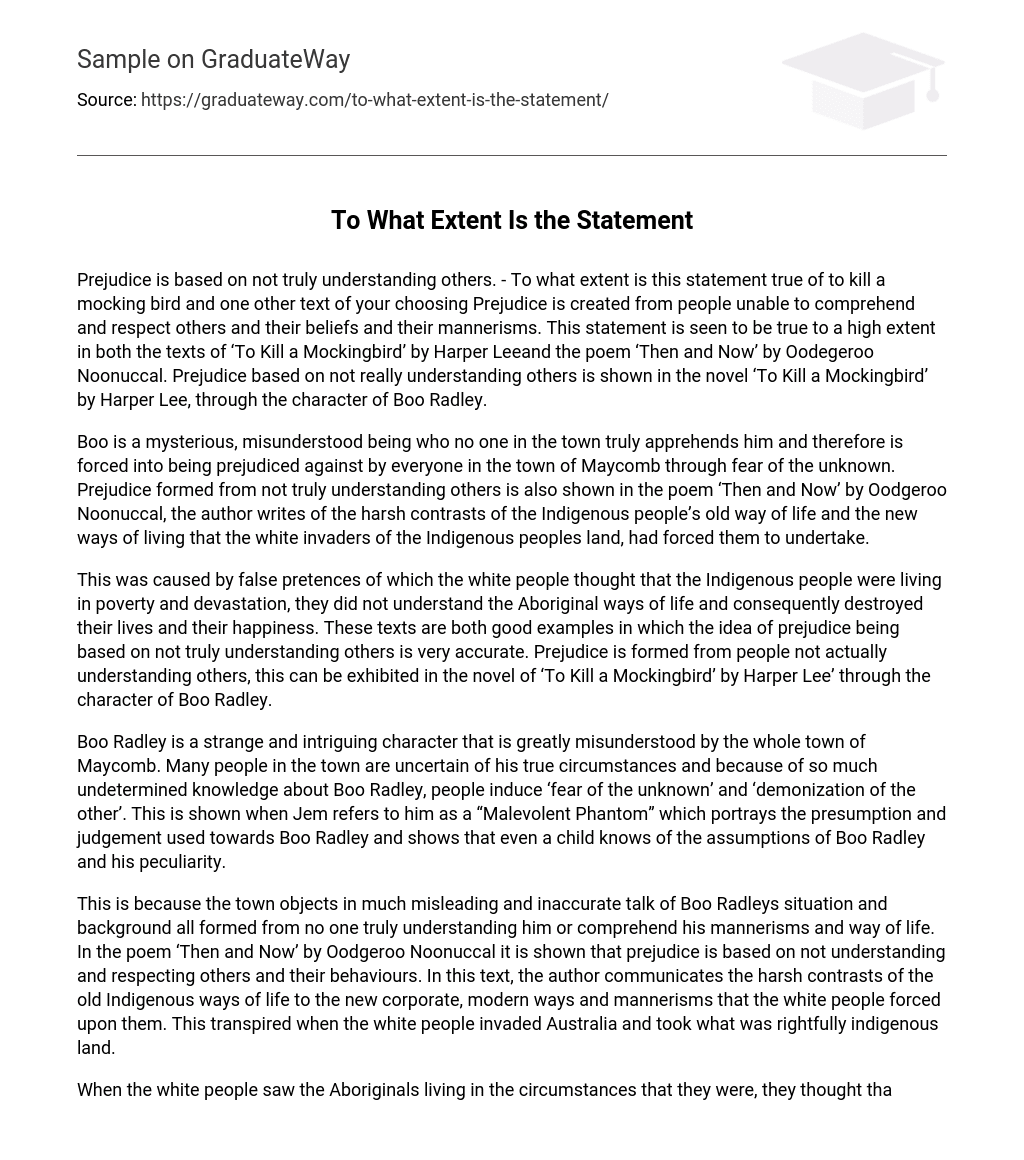Prejudice is based on not truly understanding others. – To what extent is this statement true of to kill a mocking bird and one other text of your choosing Prejudice is created from people unable to comprehend and respect others and their beliefs and their mannerisms. This statement is seen to be true to a high extent in both the texts of ‘To Kill a Mockingbird’ by Harper Leeand the poem ‘Then and Now’ by Oodegeroo Noonuccal. Prejudice based on not really understanding others is shown in the novel ‘To Kill a Mockingbird’ by Harper Lee, through the character of Boo Radley.
Boo is a mysterious, misunderstood being who no one in the town truly apprehends him and therefore is forced into being prejudiced against by everyone in the town of Maycomb through fear of the unknown. Prejudice formed from not truly understanding others is also shown in the poem ‘Then and Now’ by Oodgeroo Noonuccal, the author writes of the harsh contrasts of the Indigenous people’s old way of life and the new ways of living that the white invaders of the Indigenous peoples land, had forced them to undertake.
This was caused by false pretences of which the white people thought that the Indigenous people were living in poverty and devastation, they did not understand the Aboriginal ways of life and consequently destroyed their lives and their happiness. These texts are both good examples in which the idea of prejudice being based on not truly understanding others is very accurate. Prejudice is formed from people not actually understanding others, this can be exhibited in the novel of ‘To Kill a Mockingbird’ by Harper Lee’ through the character of Boo Radley.
Boo Radley is a strange and intriguing character that is greatly misunderstood by the whole town of Maycomb. Many people in the town are uncertain of his true circumstances and because of so much undetermined knowledge about Boo Radley, people induce ‘fear of the unknown’ and ‘demonization of the other’. This is shown when Jem refers to him as a “Malevolent Phantom” which portrays the presumption and judgement used towards Boo Radley and shows that even a child knows of the assumptions of Boo Radley and his peculiarity.
This is because the town objects in much misleading and inaccurate talk of Boo Radleys situation and background all formed from no one truly understanding him or comprehend his mannerisms and way of life. In the poem ‘Then and Now’ by Oodgeroo Noonuccal it is shown that prejudice is based on not understanding and respecting others and their behaviours. In this text, the author communicates the harsh contrasts of the old Indigenous ways of life to the new corporate, modern ways and mannerisms that the white people forced upon them. This transpired when the white people invaded Australia and took what was rightfully indigenous land.
When the white people saw the Aboriginals living in the circumstances that they were, they thought that they were living in poverty and inferiority. Over time the white people tried to throw the Indigenous people into our urbanised and materialistic environment, this was caused through the misunderstanding in which the white people thought that the Aboriginals were miserable and disconnected from the civilised world, when in fact in the contrary the Aboriginals were so content with their free and pleasurable ways of life, yet were thrown into these completely contrasted mannerisms.
In the poem, Noonuccal writes “Now I am civilized and work in the white way, Now I have dress, now I have shoes; ‘Isn’t she lucky to have a good job! ’ better when I only a dillybag. Better when I had nothing but happiness”, this shows both the indigenous peoples feelings towards becoming urbanised and the white peoples views on them becoming civilised through repetition. It portrays how the Aboriginals were given clothes and shoes to wear like the white community, and a job in the white society. Isn’t she lucky to have a good job” implies the words of the white community towards the Indigenous people, as they genuinely think that the Aboriginals are lucky to be getting jobs among the other white people because they are so beneath the white community and out of touch with society that they are privileged that the white people have helped them merge into society. “Better when I had only a dillybag.
Better when I had nothing but happiness. ” Portrays the feelings of the Aboriginals towards this new environment amongst the white people, these words give us a sense of the writers longing to be back in the times when they were “children of nature”. This shows prejudice based on not truly understanding others, as the white people didn’t apprehend the mannerisms of the Indigenous people.
Prejudice is based on people unable to comprehend and understand others and their behaviourisms and beliefs. This idea is shown to be very true through the texts of ‘To Kill a Mockingbird’ by Harper Lee and ‘Then and Now’ by Oodgeroo Noonuccal. Prejudice formed from the misunderstanding of others in the novel ‘To Kill a Mockingbird’ is portrayed through the character of Boo Radley as the whole town judges him and misapprehend his situation.
Prejudice created from people misunderstanding others is also shown through the poem ‘Then and Now’, Oodgeroo Noonuccal writes of the contrasting ways of life from the old ways of Indigenous people and the new ways that the white people have forced them into. This communicates the idea of prejudice based on not truly understanding others as this prejudice was created from misunderstanding the Indigenous peoples wishes and beliefs. Prejudice is undeniably formed from us as humans misunderstanding and judging others and their mannerisms and beliefs.





